Blog 10
When comparing my first blog and my expectations to now I would say that I’ve accomplished my goals in this class. One of the concepts I talked about wanting to learn about was prejudice and discrimination. The unit we did on this was informative and I did one of my items to archive on this subject and will choose it as one of my five top artifacts at the end of class. Also I have learned how to think about my own processing and predisposed schemas and heuristics. Since taking this class I feel as if I take a step back before making a judgement about a person or a situation and think through my true motivations. I do feel as if I have achieved the course objectives in this class. We covered all the material listed and I applied this to my personal goals for this class.
As far as how my attitudes about Social Psychology have changed, I definitely had never thought of it as a science before this class. The textbook did a thorough job in providing research to back up the theories, which is something we did not really do in Sociology. What I would do differently would be to study more for my tests. This is my first semester taking a full time load and I have had to adjust my time management to compensate for that, and I would add that this is a way I’ve grown academically.
Another way that I’ve grown academically due to this class is connecting my learning to other classes. The part of the course that made me think the hardest was about the connections between classes and I felt that was valuable self-evaluation. A skill I have learned that I can apply to my professional life is identifying that group mentalities don’t always reflect individual mentalities. Working with teenagers it is easy to ascribe a group mentality, and sometimes that is valid, but sometimes it’s not. Knowing how to differentiate is an important skill.
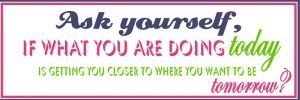
I chose this quote because I have to remind myself everyday to keep going to reach my dreams. It’s easy to want to give up. Being able to manage my time is what will make me most successful in college and making sure that everyday I am working towards that goal is important.
Blog 9
When I reflect on this course the top things that have stood out to me so far are the assignments on stereotyping, heuristics, and racism. One assignment was to watch a video of a famous comedian getting very angry and making seemingly racist comments to an audience member. I feel like this applies to a top artifact that I did earlier in the course on heuristics for module 4. We often make assumptions about situations based on our own heuristics. When watching the video of the comedian it is easy to apply a representative heuristic because when we hear people make racist comments then it is assumed they are racist. Michael Richards is adamant that he is not racist, he was simply angry. This links to chapter 10 on aggression. Specifically, the drive theory of aggression which is where something external causes someone to become frustrated and therefore act aggressively.
I can connect this course to my Human Cognition class with heuristics. We make judgement calls on a daily basis depending on our own built in heuristics. Sometimes those judgements are good, and sometimes they aren’t. This is especially true of the representative heuristic. In Human Cognition they did studies on this very subject asking people to make judgements of an individual given very little information. People most often used representative heuristics to decide what the occupation of an individual was based on this information. According to that textbook sometimes this method works, and sometimes it doesn’t. Social psychology says that it is something we do automatically because if we stopped to think through every single situation with every person, we would never make it through the day. The bottom line is that both texts state that its important to constantly reevaluate our beliefs and adjust them with new information.
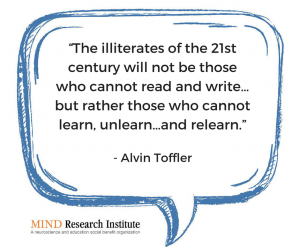
I chose this quote because it relates to reevaluating ourselves and making changes to our views.
Blog 8
One thing I learned in my biology class is that for evolution to occur, then a species has to be able to successfully reproduce and there needs to be a variety in the population. Perhaps this explains why men’s genes, according to the article, cause them to be more likely to have multiple sexual partners. Of course, in our society we don’t think this way, but I wonder how much of what we do as humans are biologically driven and we don’t realize it. I agree with the author that every physical relationship has sexual tension. It is what initially attracts us to each other in most cases. A healthy relationship will be able to have conversations about these conflicts and overcome them together.
One way that men upset women is by undervaluing them. Also, men expecting women to strictly adhere to gender roles can be upsetting. Especially in modern times where women are more independent and are helping to economically support the household. Finally, men upset women by not talking about their feelings. Most women want to know how their men are feeling and many men don’t want to admit they have any vulnerable feelings.
A way that women upset men is by nagging, at least to the man’s perspective. This often causes a lot of built up tension in the relationship. Another way that women upset men is by withholding sex if they are angry about something. Additionally, women generally don’t come right out and say what they are thinking. They expect men to read between the lines and most men just can’t do that.

Blog 7
Self-regulation and emotional intelligence are linked in that in order to self-regulate we must be emotionally intelligent enough to be aware of our emotions and how we can control them. Our emotions are directly tied to our thoughts according to the video. Being able to recognize that they are interconnected and to try and separate our thoughts from our emotions is important for self-regulation. Having emotional intelligence is important so that we can react emotionally appropriate in a given situation. It also means being aware of others emotions and how we can interact with them to perhaps help them regulate their own emotions.
I try to use emotional intelligence at work. I work with high schoolers and it is so important to be able to self-regulate my own emotions and be aware of others emotions. Often teenagers come in with a lot of baggage and they tend to show that with their teachers or other staff. One thing I’ve learned in my trainings is to not take it personally, QTIP. I’ve even written it on my hand before to remind me that it’s not personal. By doing this I am able to step outside of my own emotional reaction, and to allow them to have theirs. We can then have a conversation about how they could have reacted differently and the impact that it can have on future interactions.
Where I need to improve my own emotional intelligence is in my relationships with my daughter and husband. I think we expect more from those we are closest to and tend to get disappointed when they don’t act a certain way. This is especially true for my adult daughter. She lives with us with her daughter and it is very challenging as she is still immature in many ways. I expect her to be more grown-up and she’s just not ready for that yet. I need to learn to separate my emotions from my thoughts and try to approach her with a calm rational mind.

Blog 6
Advertising is everywhere in our society. It’s on television, billboards, the radio, and on our social media. As a matter of fact, it’s so commonplace we often tune out the advertising, or fast forward through it on our DVR’s. One thing that stood out to me in this video is that even though we may feel like we don’t pay attention to advertising, we are subconsciously aware of it.
I’ve always been aware of how ads portray many negative stereotypes towards women. I remember as a child being embarrassed about feminine hygiene or women’s underwear ads coming on the television if my dad or brother was in the room. When I was an older teenager and young adult, Victoria’s Secret ads always made me feel self-conscience. I used to read teen magazines and wanted to look like the girl’s in the ads. Of course, I never did.
The video was recorded in the 1980’s but is still very relevant. The only major change I’ve noticed is that children aren’t portrayed as sexual objects as much as they were then. We still have predominately white, heterosexual, young, and beautiful people in advertising. Jean Kilbourne did a good job explaining how what seems like innocuous advertising has a deeper, often negative, message. Many ads portray women as objects, not people, even reducing them to nothing but body parts. They are often portrayed in a very unnatural manner that isn’t realistic in life. One thing she pointed out was that ads don’t just sell products, they sell values, love, and romance that is often unattainable or unrealistic. Until watching this video I hadn’t really paid attention to how pervasive and sinister these ads can be. Just a quick Google search showed disturbing results.
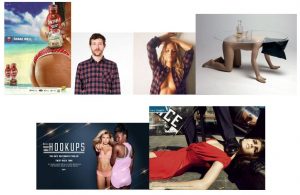
I chose these particular images because I felt like they were relevant to the video. The first image is just a woman’s butt and a protein drink. The caption says “shake well and enjoy.” The second ad is for a shirt. On the man the shirt is buttoned up to his neck and he is in a very neutral pose. The woman, however, has the shirt unbuttoned and is in a sexy pose. The third ad is a woman on all fours with a bag over her head and a table on her back. On the table is two glasses and a bottle of alcohol. The intent of this ad is to portray the woman as just furniture and not a person. The fourth ad is a Victoria’s Secret ad featuring two women in their underwear. It says “hot hookups” and then a description of the bra they are selling. “Hot Hookups” is in large letters and the sexual intent is very clear. The final ad depicts violence against a woman. She is laying on the ground and a police officer’s shoe is on her throat. In the background is a man with a riot mask on. What these ads have in common is their objectification of women in a couple of different forms. These are recent ads which proves that nothing has changed since the video was done in 1987.
Blog 5
Credible Source:
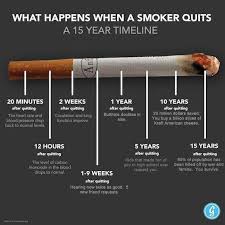
I chose this ad for my credible source because it contains statistics. This ad portrays a 15 year timeline of what happens to your body after you quit smoking. Statistics are very powerful images for people and most consider ads that contain them to be credible. This particular ad has statistics regarding ones health, which most people consider credible.
Non-Credible Source

I chose a campaign ad to represent my non-credible source. Campaign ads are notoriously biased and self-serving. Especially attack ads, which this one is. This ad is from the Obama campaign stating that the opponent, Mitt Romney would not be a good president essentially. Politicians running for reelection are always self-serving in some fashion, but when the ad has an obvious bias or slant, as this one does, it marks it as non-credible right away.
Attractive Source
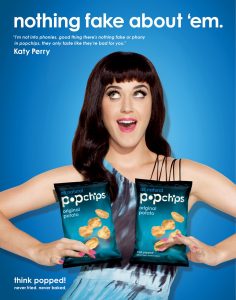
I chose this ad for chips featuring Katy Perry because she is an attractive person by most standards. The implication is that you can eat these healthier chips and look like Katy Perry by doing so. The ad includes a quote by Perry stating that she essentially doesn’t like fake things which implies that the chips are therefore not artificial. This is an important viewpoint that advertisers want to impart to their customers so they will pay more for their product.
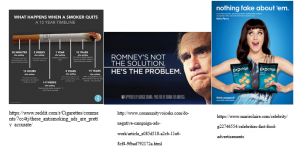
Blog 4
One of my issues with test taking is I second guess myself. A couple of the questions I missed are due to that. Looking up the correct answers in the text will hopefully solidify the information that I missed. I believe we learn more from our mistakes sometimes, than what we do right. I think it can be more meaningful, and when we attach meaning to things they tend to go into our long-term memory. I did space out my review over the period before the test. I worked on a chapter a day. One thing I need to do differently for the next test is to add to my notes when reviewing the Jeopardy videos posted. I did not do that and I think it would help.
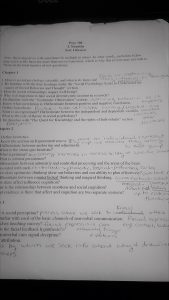
Blog 3
I do believe music links us together with others. When my husband I started dating we would give mix tapes to each other with music that was important to each of us. We had the same taste in music and it gave us a link, something to talk about. Similarly, my children and I like the same type of music. They are grown now, but my daughter always plays a new song for me when we are in the car together. It’s important to her to share that with me. When she was around 6 we would play music loudly and dance in her room. She loved it, but one song in particular she remembers specifically, “Hey Ya” by Outkast. I think it was the part about shaking it like a Polaroid picture and we would. She still talks about that even though she’s 20. I believe we share similar values and ideals, especially my husband and I. My daughter is learning her own path which includes rejecting the values and ideals with which she was raised, at least to some extent. However, music allows us to have a connection and conversation.
Music List:
My husband: “Come on Get Higher” (Matt Nathanson)
My love of all things astronomy: “Drops of Jupiter” (Train)
My Biological Father: “Father” (Demi Lovato)
My Ex-husband: “Dead Inside” (Muse)
My Granddaughter: “You Are My Sunshine” (Jimmie Davis, Charles Mitchell)
My Daughter: “Hey Ya” (Outkast)
“Look up at the stars, not down at your feet. Try to make sense of what you see, and wonder about what makes the universe exist. Be curious.” Stephen Hawking

http://twanight.org/newTWAN/photos.asp?ID=3002739
Blog 2
“What kind of student am I?”
I am typically a very self-confident student. I finished my Associate’s Degree in the top 5% of my class which helped to boost my confidence going into ODU. Getting good grades is an intrinsic motivator for me. My family always tells me that it is okay to not get an A on everything, but that is my goal. What helps is that I am good at time management and I like to get assignments done early when possible. This semester my confidence isn’t as high because it is my first semester taking full-time classes and working full-time. I am also unfamiliar with how my assignments will be graded and usually fret until I get my first grades in. A factor that can help me is to spend more time studying unfamiliar content and to revisit it. I tend to get through a module and don’t look back at it. I know this will come back to haunt me for test time. I plan to go make flashcards and diagrams for one of my classes that I know will help.
My self-efficacy results were pretty high. I believe I am in control of my own destiny and with hard enough work I can accomplish anything. Sometimes my motivation goes down, but then I remember my goal of graduating and that often works to get my motivation back. I completed my 2-year degree despite raising my children, working full-time, and then helping to raise my granddaughter. I feel like if I can do that, I can do anything!
Confidence
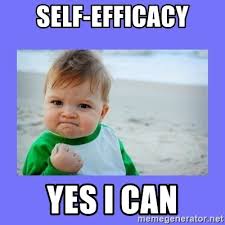
https://memegenerator.net/instance/65212473/baby-fist-self-efficacy-yes-i-can
I chose this meme because it reflects the determination that it takes to get things done. Self-efficacy is the belief in oneself that you can do anything you set your mind to.
Blog 1
The reason I signed up for this course was to help me in my career. My ultimate goal is to become a Special Education teacher and to that end I feel as if understanding the nuances of Social Psychology are vitally important. Not only do Sped teachers have to interact with students, they interact with staff, and parents. What stood out to me as far as the course objectives go is the idea of understanding how to perceive others and attempt to understand them. I currently work with teenagers and they are a difficult group to perceive. Also, discussing prejudice and discrimination are vitally important to me as well, not only for my job but for real life, too. My granddaughter is bi-racial and I know she will be discriminated against. I see it every day in my job. Other students discriminate and judge bi-racial children. I also work with students who represent several different ethnicities or cultures. My goal is to never make a student feel like I am prejudiced or discriminatory against them. It is important to me that every student feel as if they are treated equally.
Strategies that I plan to implement include reading the text and taking thorough notes. I also try to relate the text to my own life and how I can use what I learn to enhance my own people skills. I feel as if I am good judge of character and can read people well, but often find out later on that I’m not as in tune as I thought I might be. Just reading the chapter on perception has made me realize how much I don’t know.
Schemas Gone Bad

https://makeameme.org/meme/wrong-fake-news-8jh7lm
The reason I chose this meme is because when I was looking through my chapter 2 notes I made a note to myself; How do I act within my own schemas? What I wrote under it was the recent conflict between the Native American man and the white student that was all over the news. This really affected me because I jumped right on the bandwagon that the student was in the wrong all based on his facial expression. I made a judgement based on my schemas that the student was smirking, so therefore he had an attitude and the Native American was innocent in the whole situation. Later it came out that there was more to the story and I had to revise my opinion of the situation. Fortunately I did not have the perseverance effect as I strive to make sure my thinking about things is right. It goes back to what I stated above where I really try hard not to be prejudiced or discriminatory.